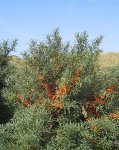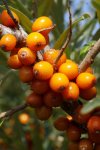Buckthorn buckthorn - hippophae rhamnoides
Family of Elk (Elaeagnaceae).
Botanical characteristics. A bush or a small tree 4-15 m high. The branches are prickly, the cortex of branches and trunk is dark gray, wrinkled. Leaves are alternate, narrow, linear or linear-lanceolate, almost sessile, dark green on top, silver at the bottom. The plant is dioecious, the flowers are unisexual. Fruits plant with female flowers, therefore for effective fructification between female trees it is necessary to plant at least one or two men for pollination. Flowers appear simultaneously with the growth of leaves. Fruits are golden yellow or orange, edible fleshy stems, sitting on very short stems. When a lot of berries, it seems that the fruits are clothed branches, which, apparently, served as the basis for the name of the plant. Blossoms in April - May, and fruits ripen in September - October.
Spread. In Russia, it is almost never seen in the wild, but it is widely cultivated in amateur gardening, and industrial cultivation also begins.
Chemical composition. The leaves of the plant contain coumarin, triterpenic acids (ursolic, olean), vitamins B1, B2, B6, C, PP, inositol, folic acid, flavonoid compounds, serotonin. A significant amount of serotonin and in the sea buckthorn bark. It is the serotonin that determines the radiation efficiency of the plant.
The flesh of fruits in its composition has a fatty oil, which consists of catechins and flavonols, carotenoids, tocopherols, beta-sitosterol, phyloquinone, phospholipids, ascorbic and nicotinic acids, folic acid, serotonin, coumarins, organic acids (malic, tartaric, oxalic, succinic ).
All parts of the plant are rich in phytoncides, tannins.
Used parts of the plant. For medicinal purposes, fruits, seeds, leaves, young branches, bark of the plant are used. The bark is harvested in the spring, berries and seeds - during the ripening period. Leaves and branches harvested in summer, as well as during the harvest of berries. The seeds are treated with sea buckthorn oil.
Application. Sea buckthorn has a general-purpose effect on metabolic processes, as well as tonic, analgesic, anti-inflammatory, hypoglycemic, antiradiation, vasodilating, wound healing. Sea-buckthorn oil is treated with radiation damage to the skin, burns, eczema, trophic ulcers, lichen, skin tuberculosis, diabetic ulcers and gangrene, inflammatory diseases of the female sexual sphere.
Juices, tinctures and broths of fruits are used for colds , diabetes, radiation damage, as a tonic and metabolism-regulating agent. In folk medicine, sea-buckthorn is an active antitumour agent.
Fresh fruits are used in medical and dietary nutrition with anemia, diabetes, gastrointestinal tract diseases, hypo- and avitaminosis, gastric ulcer, liver and kidney diseases, after severe infectious diseases.
Broth of the bark of sea buckthorn and young branches with leaves is known as an antitumor and antiradiation agent. In addition, of the decoction of the leaves, baths are prepared and poultices are made for pains in the joints (gout, rheumatism).
Infusion of leaves is drunk as tea with diarrhea, atherosclerosis, hypertension and symptomatic hypertension.
The decoction of the sea buckthorn seeds acts indulgently, wound healing, stimulates and strengthens hair growth.
Sea buckthorn oil activates the restoration of liver cells in chronic alcoholism, diseases associated with chronic toxic effects on the liver.
Preparation
- Decoction of the leaves of sea buckthorn crustacea : 1 tbsp. L. Dry crushed leaves pour 1 glass of water and boil for 3 minutes. Insist 1 hour, filter and take 0.5 glasses at night with diabetes mellitus, anemia, peptic ulcer, radiation damage.
- Infusion of the leaves of sea-buckthorn berries : 1 tbsp. L. Dry crushed leaves pour 1 cup of boiling water and insist 2 hours. Filter and take a quarter cup 3-4 times a day before meals with post-radiation syndrome, diabetes, peptic ulcer, anemia.
- Decoction of the fruit of sea buckthorn crustacea : 1 tbsp. L. Dry fruits pour 1 glass of water and boil for 3 minutes. Insist 1 hour, filter and drink 1 glass 3 times daily before meals with peptic ulcer, liver disease, colds, diabetes mellitus with vascular complications, atherosclerosis, hypertension.
- Decoction of the sea buckthorn crustacean : The bark of young branches is collected in late spring and dried, and then ground. 1 tbsp. L. Powder pour 2 cups of boiling water and boil for 10 minutes. Insist 30 minutes, strain and drink a quarter cup 3 - 4 times a day for tumors, after radiation damage.
- Decoction of sea buckthorn seeds : 1 tbsp. L. Raw materials are poured with boiling water (a glass and a half) and boiled for 5 minutes. Insist 1 hour, filter and take a glass at night with constipation.
- Tincture of sea buckthorn berries: Fresh berries are poured with alcohol (70 °) in a ratio of 1:10 and insist 2 weeks in a dark place. Express the tincture and take 20 drops 3 times a day after meals as a tonic, sugar-reducing, antiradiation agent.
- Oil from the seeds of sea-buckthorn ramskin : Mature fruits squeeze. The puff is dried at a temperature of no higher than 60 ° C, ground, poured in glass or enameled dishes with olive, sunflower or corn oil, heated to a temperature of 40-50 ° C and insisted 7 days at room temperature in a dark place, shaking and stirring periodically. The retired lower layer is drained and stored in a cool, dark place, applied according to indications both externally and inward.





Comments
Commenting on, remember that the content and tone of your message can hurt the feelings of real people, show respect and tolerance to your interlocutors even if you do not share their opinion, your behavior in the conditions of freedom of expression and anonymity provided by the Internet, changes Not only virtual, but also the real world. All comments are hidden from the index, spam is controlled.